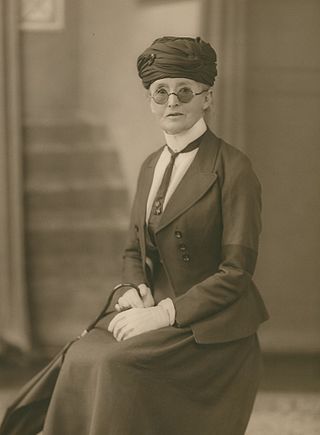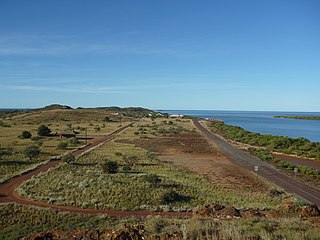Related Research Articles

The Kimberley is the northernmost of the nine regions of Western Australia. It is bordered on the west by the Indian Ocean, on the north by the Timor Sea, on the south by the Great Sandy and Tanami deserts in the region of the Pilbara, and on the east by the Northern Territory.

Daisy May Bates, CBE was an Irish-Australian journalist, welfare worker and self-taught anthropologist who conducted fieldwork amongst several Indigenous nations in western and southern Australia. Bates was a lifelong student of Australian Aboriginal culture and society and was the first anthropologist to carry out a detailed study of Australian Aboriginal culture. Some Aboriginal people referred to Bates by the courtesy name Kabbarli "grandmother."

Ernestine Hill was an Australian journalist, travel writer and novelist.
The Boonwurrung people are an Aboriginal people of the Kulin nation, who are the traditional owners of the land from the Werribee River to Wilsons Promontory in the Australian state of Victoria. Their territory includes part of what is now the city and suburbs of Melbourne. They were called the Western Port or Port Philip tribe by the early settlers, and were in alliance with other tribes in the Kulin nation, having particularly strong ties to the Wurundjeri people.

Makassar people from the region of Sulawesi in Indonesia began visiting the coast of Northern Australia sometime around the middle of the 18th century, first in the Kimberley region, and some decades later in Arnhem Land. They were men who collected and processed trepang, a marine invertebrate prized for its culinary value generally and for its supposed medicinal properties in Chinese markets. The term Makassan is generally used to apply to all the trepangers who came to Australia.

Norman Barnett Tindale AO was an Australian anthropologist, archaeologist, entomologist and ethnologist.

Cossack, known as Bajinhurrba in Ngarluma language, and formerly known as Tien Tsin, is an historic ghost town located 1,480 km (920 mi) north of Perth and 15 km (9.3 mi) from Roebourne in the Pilbara region of Western Australia. The nearest town to Cossack, which is located on Butcher Inlet at the mouth of the Harding River, is Wickham. The former Tien Tsin Harbour is now known as Port Walcott. Since 2021, the townsite is managed and operated by the Ngarluma and Yindjibarndi Foundation Ltd (NYFL).

Whadjuk, alternatively Witjari, are Noongar people of the Western Australian region of the Perth bioregion of the Swan Coastal Plain.

Elizabeth Durack Clancy CMG, OBE was a Western Australian artist and writer.
James Ronald Chi was an Australian composer, musician and playwright. His best known work is the 1990 musical Bran Nue Dae which was adapted for film in 2009.

Pearling in Western Australia includes the harvesting and farming of both pearls and pearl shells along the north-western coast of Western Australia.

The history of Indigenous Australians began at least 65,000 years ago when humans first populated the Australian continental landmasses. This article covers the history of Aboriginal Australian and Torres Strait Islander peoples, two broadly defined groups which each include other sub-groups defined by language and culture.
Beagle Bay is a medium-sized Aboriginal community on the western side of the Dampier Peninsula, north of Broome in the Kimberley region of Western Australia.

Olive Muriel Pink was an Australian botanical illustrator, anthropologist, gardener, and activist for Aboriginal rights.
Noongar is an Australian Aboriginal language or dialect continuum, spoken by some members of the Noongar community and others. It is taught actively in Australia, including at schools, universities and through public broadcasting. The country of the Noongar people is the southwest corner of Western Australia. Within that region, many Noongar words have been adopted into English, particularly names of plants and animals.

The Australian frontier wars were the violent conflicts between Indigenous Australians and non-Indigenous settlers during the colonisation of Australia. The first conflict took place several months after the landing of the First Fleet in January 1788, and the last frontier conflicts occurred in the early 20th century, with some occurring as late as 1934. An estimated minimum of 100,000 Indigenous Australians and between 2,000 and 2,500 settlers died in the conflicts. Conflicts occurred in a number of locations across Australia.
William Harris (1867–1931) was an early Western Australian activist for Aboriginal civil rights. He has been called "the most significant voice of a generation with the education and social standing to assert their rights as British subjects".
Ngumbarl is an extinct Nyulnyulan language formerly spoken in Western Australia.

The Arabana, also known as the Ngarabana, are an Aboriginal Australian people of South Australia.
Lyn Henderson-Yates is an Aboriginal Australian social scientist professor and deputy-vice chancellor of the Broome campus of University of Notre Dame Australia in Western Australia. She is the first Aboriginal woman to be hired to this position in any university across Australia.
References
- ↑ "Treasures of the Battye Library Western Australia: Drawings by Billingee". State Library of Western Australia. Retrieved 15 June 2019.
- 1 2 Cynthia Coyne, '"Bye and Bye when all the Natives have gone': Daisy Bates and Billingee", in Uncommon Ground: White Women and Aboriginal History, ed. Anna Cole, Victoria Haskins and Fiona Paisley (Aboriginal Studies Press, 2005)